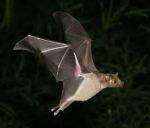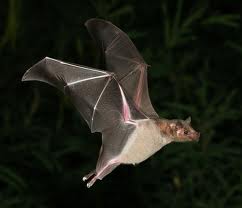
 Bats are the only mammals capable of true flight. With extremely elongated fingers and a wing membrane stretched between, the bat’s wing anatomically resembles the human hand,Almost 1,000 bat species can be found worldwide. In fact, bats make up a quarter of all mammal species on earth!
Bats are the only mammals capable of true flight. With extremely elongated fingers and a wing membrane stretched between, the bat’s wing anatomically resembles the human hand,Almost 1,000 bat species can be found worldwide. In fact, bats make up a quarter of all mammal species on earth!
Fast Facts
Size: Bats are divided into two suborders: Megachiroptera, meaning large bat, and Microchiroptera, meaning small bat. The largest bats have a 6 foot wingspan. The bodies of the smallest bats are no more than an inch long.
Lifespan: Most bats live longer than most mammals of their size. The longest known lifespan of a bat in the wild is 30 years for a little brown bat.
A single little brown bat can eat up to 1000 mosquitoes in a single hour, and is one of the world’s longest-lived mammals for its size, with life spans of almost 40 years.
Diet
70% of bats consume insects, sharing a large part of natural pest control. There are also fruit-eating bats; nectar-eating bats; carnivorous bats that prey on small mammals, birds, lizards and frogs; fish-eating bats, and perhaps most famously, the blood-sucking vampire bats of South America.
Population
While some bat populations number in the millions, others are dangerously low or in decline.
Range
Bats can be found almost anywhere in the world except the polar regions and extreme deserts.
Echolocation
Some bats have evolved a highly sophisticated sense of hearing. They emit sounds that bounce off of objects in their path, sending echoes back to the bats. From these echoes, the bats can determine the size of objects, how far away they are, how fast they are traveling and even their texture, all in a split second
Bats find shelter in caves, crevices, tree cavities and buildings. Some species are solitary while others form colonies of more than a million individuals.
Overwintering
To survive the winter some species of bat migrate, others hibernate, and yet others go into torpor (regulated hypothermia that can last from a few hours to a few months).
Did You Know?
Giant flying foxes that live in Indonesia have wingspans of nearly six feet!
Reproduction
Gestation: 40 days – 6 months (bigger bats have longer gestation periods)
Litter Size: Mostly one pup
For their size, bats are the slowest reproducing mammals on Earth. At birth, a pup weighs up to 25 percent of its mother’s body weight, which is like a human mother giving birth to a 31 pound baby! Offspring typically are cared for in maternity colonies, where females congregate to bear and raise the young. Male bats do not help to raise the pups.
Climate Change and Other Threats
The greatest threat to bats is people. Habitat destruction and fear are a lethal combination for bats. In some areas, people have even been known to set fires in caves, killing thousands of roosting bats. Bats are also killed by harmful development projects such as wind turbines that are placed along migratory routes. In addition, an emerging disease called white nose syndrome is killing large numbers of hibernating bats in North America.
Climate change could impact bats as well. Over the past 15 years, 30,000 flying foxes – the largest bats in the world – in Australia have succumbed to heat stress during heat waves that push daytime temperatures above 100 degrees Fahrenheit. For bats that depend on nectar or fruits, changes in plant flowering timing could put them out of sync with their food sources. And it remains an open question as to whether the devastation of white nose syndrome is somehow linked to stress from a changing climate.
Legal Status/Protection
- Endangered Species Act (ESA): Twelve species of bat are listed as endangered, and one as threatened.
- CITES: Some species of bats are protected under Appendix I and some under Appendix II.
Reasons For Hope
Renewable energy, such as wind and solar power, is crucial to the future of our planet. However, ensuring that renewable energy sources, such as wind turbines, cause as little environmental harm as possible is just as important. Some wind farms have proven deadly to bats, which suffer fatalities both from collisions and also from simply passing too close to the blades, where sharp changes in air pressure cause a lung injury called “barotrauma.” For reasons that are unclear to scientists, facilities placed on Appalachian ridge tops have caused particularly high fatality rates, but multiple bat deaths have been reported at other facilities as well.
Defenders and other conservation organizations are working with federal and state agencies to look for places where wind turbines can be set up in safely by avoiding birds and bats.

